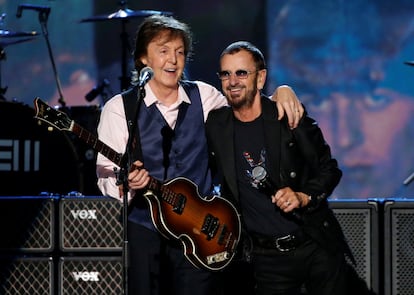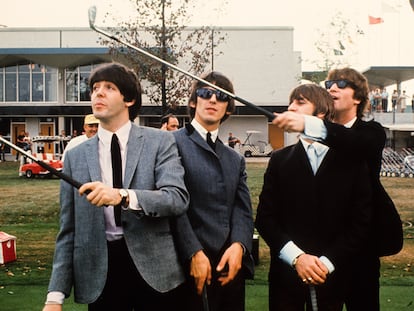Would Lennon approve of ‘The Last Beatles Song’?
The ‘Now and Then’ mini-documentary focuses on demos John left unfinished, expecting that McCartney would complete them

The final song by the real, live Beatles is titled The End and was recorded in the summer of 1969. It’s the last track on Abbey Road’s remarkable side two, most of which consists of a 16-minute medley of eight tracks of short songs and song fragments. The End features impressive guitar solos by Lennon, McCartney and Harrison and Ringo Starr’s drum solo. The song ends with all four Beatles singing, “And in the end, the love you take away will be equal to the love you make.”
The Now And Then – The Last Beatles Song mini-documentary was uploaded to YouTube hours before the song itself was released on November 2. The song was reconstructed from a cassette tape that John had recorded at home shortly before his death in 1980. Yoko Ono sent the tape, with the words “For Paul” on a Post-It note, to McCartney, who has now completed the song with Ringo.
The short film lasts only 12 minutes, so it didn’t discourage Beatles fans who endured the eight hours of Get Back, Peter Jackson’s 2021 documentary of the Let It Be sessions in January 1969. Before that, we watched over 10 hours of The Beatles Anthology, the 1995-1996 series that chronicled their entire career with abundant unpublished material. The two new songs released as part of Anthology — Free as a Bird and Real Love — were unfinished Lennon songs completed by the surviving Beatles. However, doing the same proved to be quite challenging with Now and Then, as the sound quality wasn’t good enough to separate John’s vocals and piano into two tracks.
The documentary focuses on telling the story of how the song was recreated. Peter Jackson used the same artificial intelligence technology employed in Get Back to isolate Lennon’s voice from his piano, using another home recording he made of Now and Then. Paul and Ringo then came into the studio to play their parts. Since George died in 2001, Paul imitated his style for the slide guitar solo. The song feels like it’s missing George’s special touch. Reminiscent of Eleanor Rigby, McCartney also brought in a string orchestra without letting the musicians know it was for a Lennon track. The violins add a nostalgic touch that wasn’t present in the original composition.
McCartney admits to having doubts about completing Now and Then, but ultimately believes Lennon would have been pleased. While using AI might make some people uneasy, it’s important to remember that the Beatles always embraced technological innovation in their music. Sean Ono Lennon thinks his father would be happy, and says he and Yoko Ono certainly are.
Would the songwriter of Imagine really approve of this? Doubtful. In God, a song from Lennon’s first post-Beatles solo album, he chants a list of things he doesn’t believe in, including the Beatles. His few solo concerts only included a couple of atypical Fab Four songs, like Come Together and Yer Blues. It’s hard to believe that John Lennon, the nonconformist who disdained his own legend, made these tapes for posterity in hopes of reuniting with his bandmates. A few months later, Lennon was tragically murdered by Mark Chapman in front of his New York apartment.
In his well-known interview with Newsweek in September 1980, published a month and a half before his death, Lennon firmly rejected the possibility of getting the band back together. Lennon said what made the Beatles and the 1960s special couldn’t be recreated. He likened reuniting the Beatles to a school reunion, something he had no interest in doing. It was definitely over.
McCartney’s doubts are valid — should they have done that song? It’s debatable. Like the original demo, Now and Then is pleasant enough and the new mix sounds good. However, it doesn’t reach the level of excellence achieved by the Beatles in the 1960s. In short, the song neither polishes nor tarnishes their unassailable legacy.
Sign up for our weekly newsletter to get more English-language news coverage from EL PAÍS USA Edition
Tu suscripción se está usando en otro dispositivo
¿Quieres añadir otro usuario a tu suscripción?
Si continúas leyendo en este dispositivo, no se podrá leer en el otro.
FlechaTu suscripción se está usando en otro dispositivo y solo puedes acceder a EL PAÍS desde un dispositivo a la vez.
Si quieres compartir tu cuenta, cambia tu suscripción a la modalidad Premium, así podrás añadir otro usuario. Cada uno accederá con su propia cuenta de email, lo que os permitirá personalizar vuestra experiencia en EL PAÍS.
¿Tienes una suscripción de empresa? Accede aquí para contratar más cuentas.
En el caso de no saber quién está usando tu cuenta, te recomendamos cambiar tu contraseña aquí.
Si decides continuar compartiendo tu cuenta, este mensaje se mostrará en tu dispositivo y en el de la otra persona que está usando tu cuenta de forma indefinida, afectando a tu experiencia de lectura. Puedes consultar aquí los términos y condiciones de la suscripción digital.
More information
Archived In
Últimas noticias
Most viewed
- Reinhard Genzel, Nobel laureate in physics: ‘One-minute videos will never give you the truth’
- Oona Chaplin: ‘I told James Cameron that I was living in a treehouse and starting a permaculture project with a friend’
- Pablo Escobar’s hippos: A serious environmental problem, 40 years on
- Why we lost the habit of sleeping in two segments and how that changed our sense of time
- Chevy Chase, the beloved comedian who was a monster off camera: ‘Not everyone hated him, just the people who’ve worked with him’











































